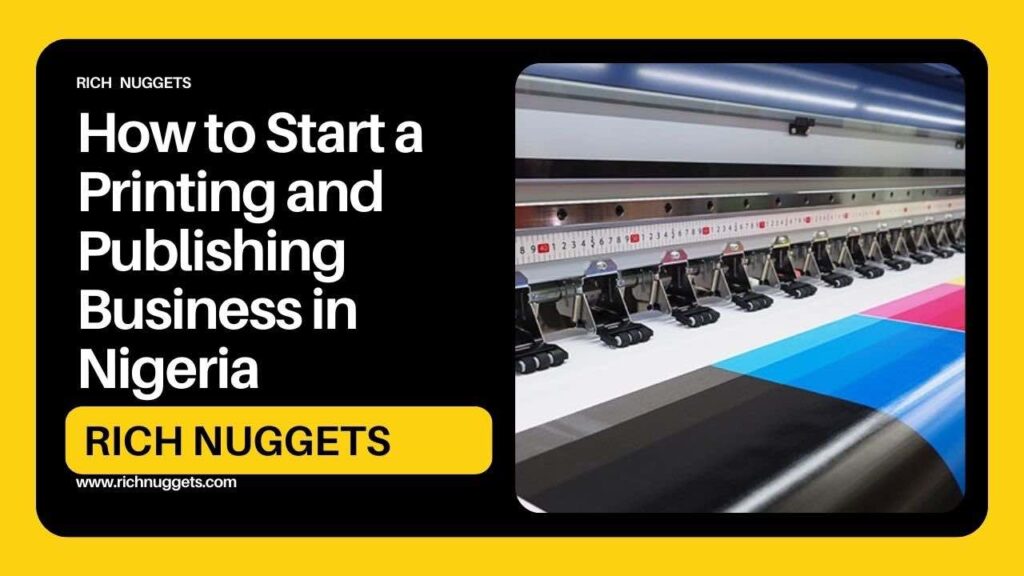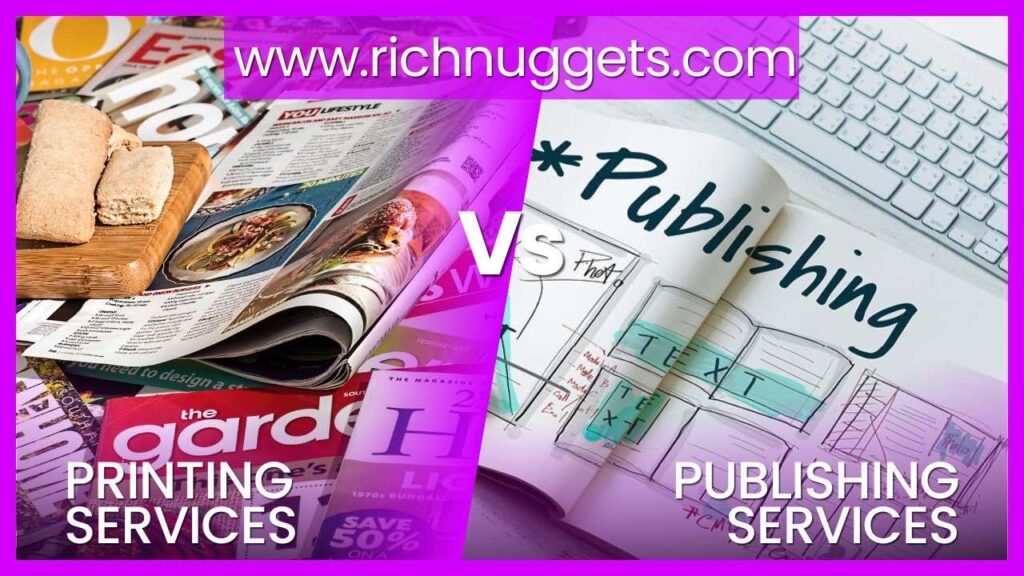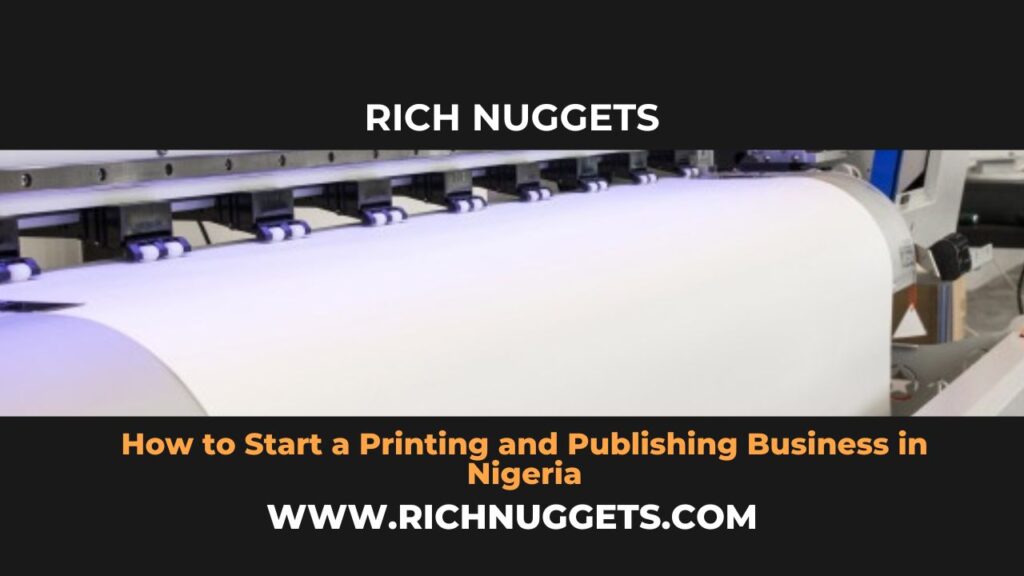
A Printing and Publishing Business in Nigeria involves the production and distribution of printed materials such as books, magazines, newspapers, brochures, flyers, posters, and other promotional materials.
This industry plays a vital role in disseminating information, preserving literature, and supporting marketing and advertising efforts.
In this article, we won’t only focus on how to start a Printing and Publishing business in Nigeria. We will also touch on the intricacies of starting one that is profitable.
Table of Contents
Difference between Printing services and Publishing services

Printing Services:
Printing services refer to the processes involved in reproducing text, images, and designs onto physical materials such as paper, fabric, or other substrates(such as the ones used for banners).
Printing services focus on producing the physical copies of materials as requested by clients.
These services include various printing techniques and processes, such as digital printing, offset printing, screen printing, and more.
The primary goal of printing services is to accurately replicate the content and design onto the chosen medium. Printing services typically involve:
- Producing tangible copies of documents, marketing materials, promotional items, and other printed matter.
- Utilizing different printing methods based on the client’s requirements and the desired quality and quantity.
- Offering options for paper types, finishes, and sizes.
- Providing services like color calibration, proofreading, and quality control to ensure accurate reproduction.
Examples of printing services: Business cards, brochures and flyers, production of books and magazines, posters and banners, calendars, invitations and greeting cards, and labels and stickers
Publishing Services:
Publishing services, on the other hand, encompass a broader set of activities that involve bringing written content from authors, writers, or content creators to a wider audience.
Publishing involves the entire process of creating, producing, and distributing content in various forms, including print and digital formats.
It goes beyond just producing physical copies and includes tasks like editing, design, layout, and distribution.
Publishing services typically include:
- Managing the entire lifecycle of content, from manuscript editing to final production.
- Collaborating with authors and content creators to refine their work.
- Designing layouts, covers, and illustrations to enhance the visual appeal of the content.
- Typesetting the text to ensure proper formatting and readability.
- Choosing the appropriate printing method or digital platform for distribution.
- Handling the logistics of printing, binding, and distributing physical copies.
- Managing digital distribution channels such as ebooks, online articles, and digital platforms.
- Preserving and archiving content for historical and educational purposes.
Examples of publishing services: Editing and proofreading, book design and layout, ISBN assignment, ebook conversion, distribution services, marketing and promotion of books, content licensing, copyright registration, editorial services, and print-on-demand services for authors.
In essence, printing services primarily focus on the accurate reproduction of existing content onto physical materials, while publishing services involve a more comprehensive process of curating, producing, enhancing, and distributing content to a wider audience, often involving multiple stages beyond just printing.
The Printing and Publishing business falls under the category of “Manufacturing” and “Media and Communication” industries
How to Start a Printing and Publishing Business in Nigeria

Here are the steps to starting your own printing and publishing business in Nigeria:
1. Defined Your Services to be Offered:
Your printing business can offer a range of printing and publishing services to customers. However, it’s smart to concentrate on a select few instead of trying to cover everything. The benefit of this focused approach is to achieve a higher level of efficiency.
Here are some types (Niches) in the printing and publishing business to consider;
- Book Printing: This involves printing books of different genres, sizes, and formats. It can include novels, textbooks, cookbooks, and more.
- Magazine Printing: Printing magazines, journals, and periodicals for various industries or interest groups. This service might involve working with publishers to create appealing layouts and designs.
- Business Card Printing: Designing and printing professional business cards for individuals and businesses. Business cards are essential for networking and making a good first impression.
- Brochure Printing: Creating and printing marketing brochures that provide information about a company, product, or service. Brochures are often used for promotional purposes.
- Flyer Printing: Similar to brochures, flyers are single-page promotional materials that are usually distributed in public places or through mail.
- Poster Printing: Printing posters for events, advertising, promotions, or decorative purposes. Posters can vary in size and design.
- Label and Packaging Printing: Providing labels for products and packaging materials. This is crucial for branding and ensuring product information is communicated effectively.
- Catalog Printing: Printing product catalogs showcasing a company’s offerings. These are commonly used by businesses in the retail and wholesale sectors.
- Customized Printing: Offering customization options for various products, allowing customers to personalize items like t-shirts, mugs, stationery, etc.
- Design Services: In addition to printing, offering design services for customers who need help creating print-ready files. This could include graphic design for book covers, brochures, logos, and more.
- Print Consulting: Providing advice and expertise to clients on the best printing methods, paper choices, and design elements for their specific projects.
- Binding and Finishing: Offering different binding options such as saddle stitching, perfect binding, coil binding, and more, along with finishing services like lamination and embossing.
- Large Format Printing: Catering to printing large-scale materials such as banners, posters, signage, and other visual displays.
- Digital Printing: Using digital printing technology to provide quick and cost-effective solutions for smaller print runs and variable data printing.
- Offset Printing: Offering high-quality and cost-effective printing for larger quantities, suitable for projects like book printing or magazine production.
By defining the range of services you plan to offer, you create a clear understanding of what your printing and publishing business can provide to potential clients. This also helps you allocate resources, set pricing, and market your services effectively.
But as your business grows you can incorporate more printing and publishing services into your own business.
2. Market Research and Business Plan:
The aspect of market research involves gathering information about the publishing and printing industry niche that you’re entering. This market research covers areas such as;
Understanding the market demand for your service
Market Trends
Knowing your target audience
Competitor analysis data
When you are done with the market research, you move to creating your business plan. This business plan document contains vital information that will be a guide to navigating the path of your printing and publishing business to become successful. The information contained in the business plan includes; Your market research findings, business goals, services, pricing strategy, marketing approach, and financial projections.
3. Legal Requirements and Registration:
In terms of meeting the legal requirement in the printing and publishing business, the first and foremost to be met is the Business registration. You will need to register your business with the Corporate Affairs Commission (CAC).
With that first legal demand fulfilled, you can proceed to obtain your Tax Identification Number and other required certifications that may be mandatory based on the type of printing and publishing business you intend to operate in Nigeria.
4. Location and Infrastructure:
Selecting the right location for your printing and publishing business is crucial as it has a significant impact on your success. Your chosen business location
should meet these criteria;
- Accessibility
- Proximity to Target Customers
- Not too crowded with competition
- Meets basic Infrastructure such as electricity, internet connectivity, and water supply
- On a moderate costs
- Has a good visibility
When you are done with securing the perfect locations the next thing to do is to get your necessary infrastructures ready. These infrastructures are:
- Printing Equipment: Depending on the types of printing services you plan to offer, acquire the appropriate printing equipment. This might include digital printers, offset printers, large format printers, and other specialized machines.
- Computers and Software: Invest in computers with sufficient processing power and memory to run design and editing software effectively. Software like Adobe Creative Suite, CorelDRAW, or specialized printing software will be crucial for creating and editing designs.
- Workstations and Furniture: Set up workstations for your employees, including comfortable chairs and ergonomic desks. Arrange the furniture in a way that promotes productivity and collaboration if needed.
- Work Area: Designate specific areas for printing, design, and administrative tasks. Ensure that the workspace is organized, well-lit, and conducive to efficient operations.
- Storage Space: Consider storage space for raw materials, printed products, and supplies. Organized storage helps prevent clutter and makes inventory management easier.
Securing the perfect location and infrastructure for your printing and publishing business will contribute to your business’s ability to deliver quality products and services to your customers.
5. Human Resources:
Human resources involves hiring employees who play various roles to contribute to the success of the printing and publishing business. These employees should in somewhat be skilled.
Here are the types of employees that are most needed in a printing and publishing business:
- Graphic Designers
- Printing Technicians
- Sales Staff
- Customer Service Staff
- Administrative Personnel, and
- Security Personnel
They collectively work together to ensure the business’s smooth operation, quality output, customer satisfaction, and safety of the business.
6. Marketing and Promotion:
This involves strategies and activities you should employ to create awareness, attract customers, and ultimately drive sales to your printing and publishing business.
In context, effective marketing for your printing and publishing business helps your business reach its potential clients, showcase your capabilities, and differentiate your services in the competitive market.
These marketing and promotional strategies may include; Online marketing, social media (paid and free options), local advertising, and networking.
By employing various marketing and promotional strategies, and showcasing your work through a portfolio, you make your services known, and convince potential clients that you can meet their printing and publishing needs effectively.
The challenges of printing and publishing business in Nigeria
Here are the challenges that besiege printing and publishing businesses in Nigeria:
- Unstable Power Supply
- Inadequate Infrastructure
- Highly Competitive
- High Importation costs due to high import tariffs
- There is a rapid evolution of technological advances in the industry
- Difficulty in ensuring consistent and high-quality printing services due to variations in equipment, materials, and skill levels.
- Finding skilled and experienced graphic designers, printing technicians, and other specialized personnel can be difficult.
- Economic fluctuations and currency volatility affect the cost of materials and equipment, as well as the purchasing power of clients.
- The lack of strict enforcement of intellectual property rights in the country has led to issues related to copyright infringement and piracy of printed materials.
- Late payments or non-payment by clients can impact cash flow, especially for smaller printing businesses.
- Changing consumer habits from things like newspapers and magazines to digital media has changed the way people consume information, affecting the demand for printed materials
- Balancing the costs of materials, labor, and overhead while maintaining competitive pricing and profitability is an ongoing challenge.
Final Thoughts
The printing and publishing business is an exciting business venture to start in Nigeria. But it demands strategic planning, dedication, and a commitment to excellence.
By following the outlined steps, from defining your services and conducting thorough market research to legal registration, infrastructure setup, and effective marketing, you’re setting the stage for a thriving printing and publishing venture.
Your ability to adapt, innovate, and continuously deliver high-quality printing and publishing solutions is the key to standing out in this dynamic and highly competitive business in Nigeria.
FAQs
How Lucrative is Printing Press Business in Nigeria?
The printing press business in Nigeria is a very lucrative business that you can start in Nigeria as an entrepreneur. The profitability of this business can be attributed to the high market demand for a printing press service, high level of efficiency and cost reduction of production as a result of technological advancements, and the diversification of your offerings.
How big is the printing market in Nigeria?
The printing market in Nigeria is expected to experience steady growth over the period between 2023 and 2028.
According to “Statista forecasts“, the revenue is projected to increase by a total of $12.1 million U.S. dollars, reflecting a growth rate of approximately 6.94%.
By the year 2028, it is estimated that the revenue in this industry will reach $186.39 million U.S. dollars.
This positive trajectory suggests that there is a significant market demand for the printing business in Nigeria.
Discover more from StartBizEasy
Subscribe to get the latest posts to your email.





